First Sergeant Harry Emanuel Buckner
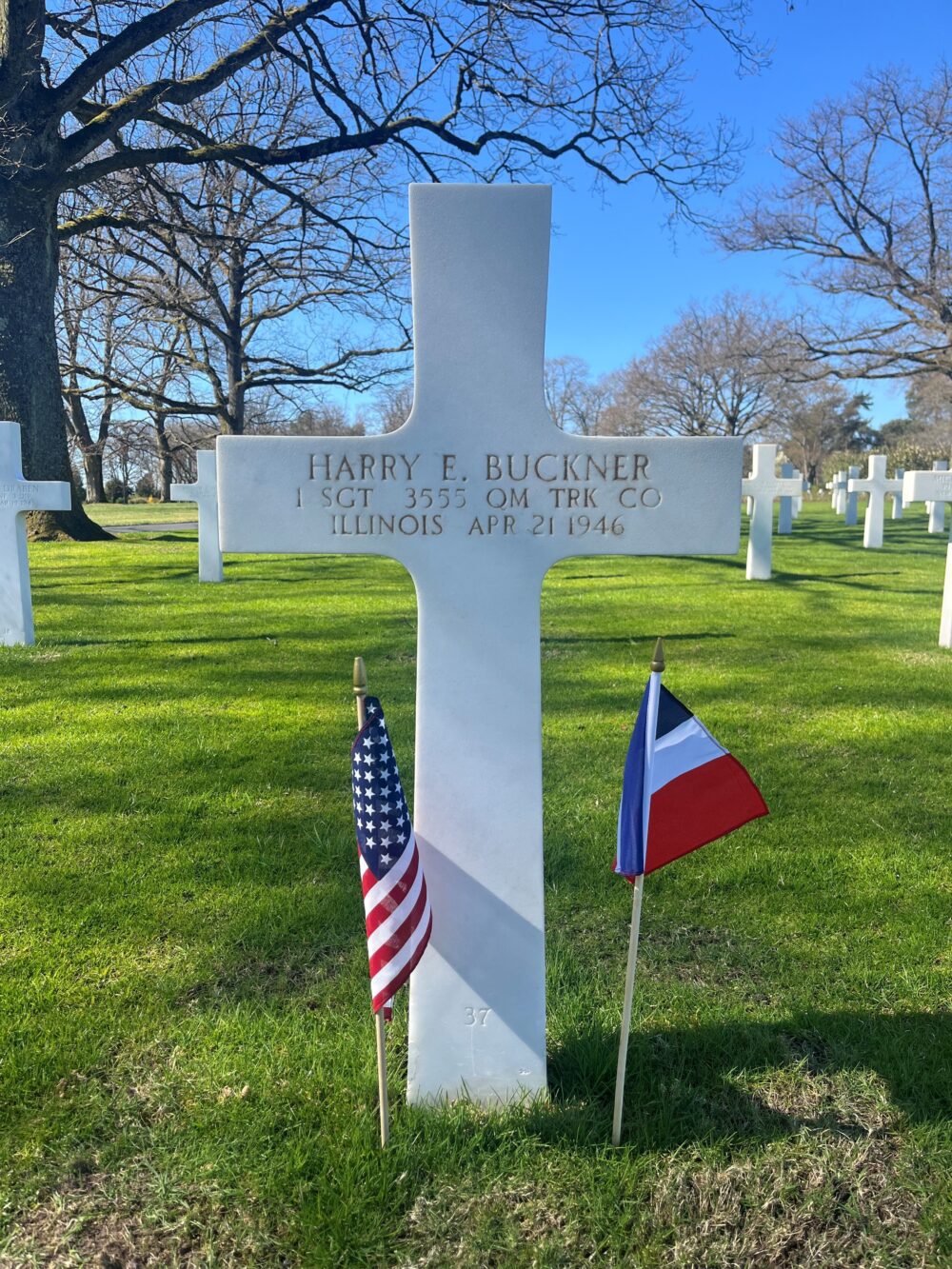
- Unit: 469th Quartermaster Group, 3555th Quartermaster Truck Company
- Service Number: 36021620
- Date of Birth: December 21, 1914
- Entered the Military: October 16, 1940
- Date of Death: April 21, 1946
- Hometown: Monroe City, Missouri and Chicago, Illinois
- Place of Death: Kafertal, Germany
- Award(s): World War II Victory Medal, American Campaign Medal
- Cemetery: Plot E, Row 13, Grave 37. Lorraine American Cemetery, Saint Avold, France
National History Day (College Park, Maryland)
2024/2025
Early Life
Harry Emanuel Buckner was born on December 21, 1914, in Monroe City, Missouri, to John David Buckner and (Mary) Ella Buckner. Harry had three siblings: Earl, Jewel, and Harold. Eventually, Harry moved to Chicago, Illinois, to live with his uncle, Emanuel Buckner, on South Vincennes Avenue in Bronzeville, a predominantly African American neighborhood. Before serving in World War II, Harry worked for David Parker, a grocer, in Chicago.

Homefront
Black Population Growth in Chicago
During World War II, African Americans migrated from the southern United States to northern cities like Detroit, Chicago, and New York. This movement was known as the Great Migration. The African American population in Chicago grew by more than 500,000 between 1940 and 1960.
The Bronzeville neighborhood of Chicago became the center of a rich cultural renaissance from the 1910s through the 1940s. Bronzeville was also home to many influential people, including Gwendolyn Brooks, Richard Wright, Louis Armstrong, Bessie Coleman, and Ida B. Wells, during this time period.
Jobs and War Production in Chicago During World War II
By the late 1930s, many people in Chicago were unemployed because of the Great Depression. Many workers began to join unions and united across race, ethnicity, and industry. By 1940, one-third of workers in Chicago’s manufacturing industry joined unions.
New federally funded jobs and services under President Franklin D. Roosevelt reinforced Democratic loyalty among new voters. Federal funds contributed to the construction of parks, schools, and roads. By the 1940s, war production orders effectively ended the Great Depression.
The value of war goods produced in Chicago ranked only second to Detroit because of its diverse industrial base. Over 1,400 companies produced supplies that included field rations, parachutes, and torpedoes. Aircraft plants employed 100,000 workers who made engines, aluminum sheeting, bombsights, and other components.
The Douglas-Chicago plant, where O’Hare International Airport is now located, produced 654 C-54 Skymaster transports in only 25 months. Over half of all military electronics used in World War II came from 60 local Chicago plants. These plants created jobs that attracted 60,000 African Americans from the southern United States and an equal number of Japanese Americans released from desert detention camps to Chicago for work. People who were physically disabled, the elderly, and women also sought work in these Chicago plants during World War II.
Victory Garden Program in Chicago During World War II
Chicago also led the nation in urban food production with its Victory Garden program. This program included 1,500 community gardens and more than 250,000 home gardens. Chicago’s North Park neighborhood was home to the largest Victory Garden in the United States. This successful program served as an example to other communities throughout the United States.
Typical Victory Gardens included fresh fruits and vegetables like carrots, green and yellow snap beans, lima beans, broccoli, beets, tomatoes, corn, and squash. Since the growing season in Chicago is short, canning was encouraged to preserve the harvest.
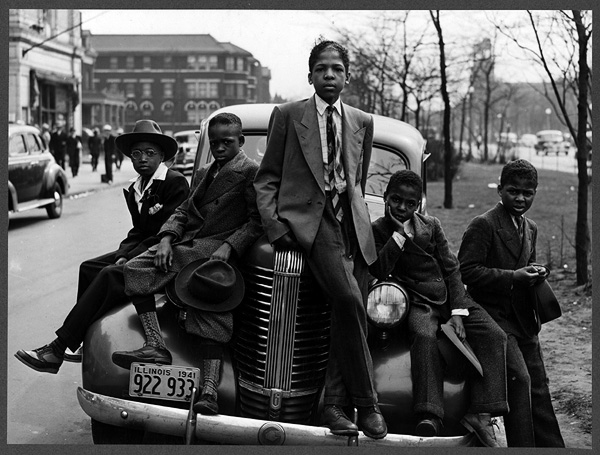
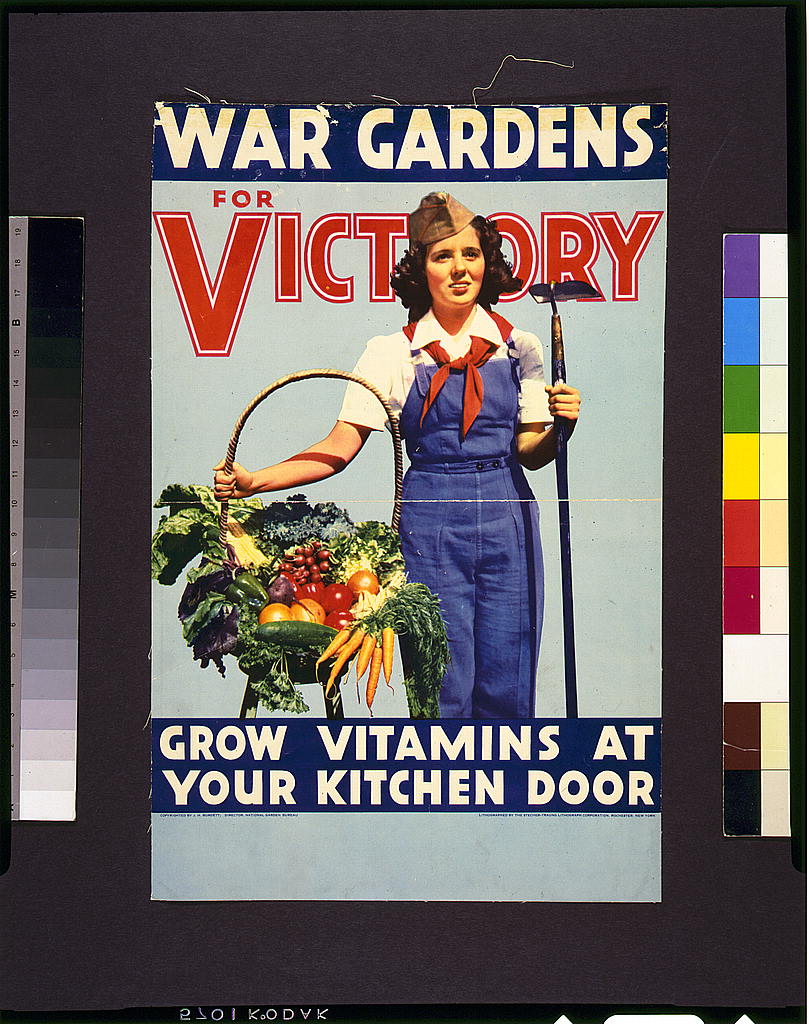
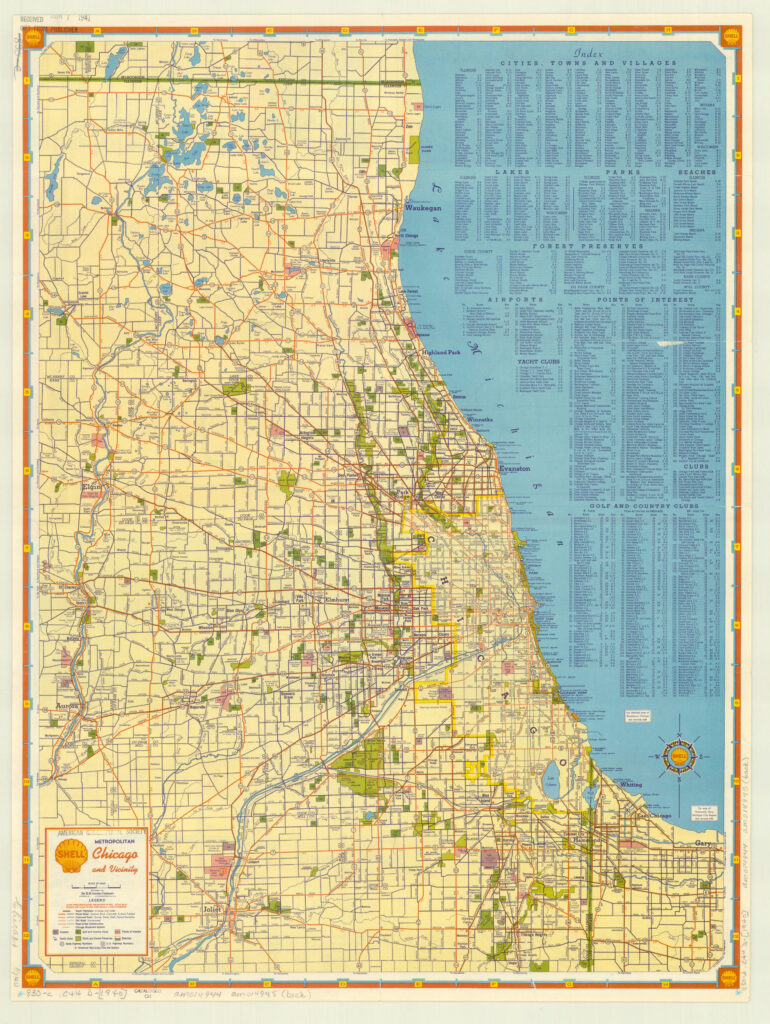
Military Experience
Harry Buckner was more than likely part of the peacetime draft prior to the attack on Pearl Harbor in December 1941. He registered for the military on October 16, 1940, at the Local Board #7 in Chicago, Illinois, on 417 E. 47th Street.
Harry was a first sergeant in the United States Army. First sergeants typically instruct other sergeants, advise commanders, and help train other enlisted soldiers. They also assist officers at the company level, who can range from 60 to 200 soldiers.
Stateside Service
Buckner was stationed at four different stations in the United States before going overseas to fight in Europe during World War II. He was initially stationed at Fort Custer, Michigan, in October 1941. More than 300,000 troops were trained at this location. He then transferred to Fort Francis E. Warren near Cheyenne, Wyoming, from October 1941 to June 1942, the location of the Quartermaster Replacement Training Center.
Harry then made his way to Fort Lewis, Washington, from June 1942 to March 1943. Finally, he was stationed at Fort George G. Meade in Maryland in March 1943. Fort Meade stationed more than 200 units and approximately 3.5 million men from 1942 to 1946.
Buckner was deployed to Europe sometime after March 1943 as part of the 469th Quartermaster Group and was assigned to the 3555th Quartermaster Truck Company. As part of the 3555th Quartermaster Truck Company, Buckner was involved in the shipping and movement of supplies and arms. After the capture of Antwerp by the Allies, the port was so damaged that it could not be used to unload ships until November 1944. Additionally, French railroads were not able to be used to move supplies across France because of the Allied bombing of bridges, steam engines, and marshaling yards to prevent Germany from taking advantage of the rail system.
The Red Ball Express
The Red Ball Express was a solution devised by American commanders to create a convoy system using U.S. Army trucks to carry rations, gasoline, ammunition, and other vital supplies non-stop to troops at the front. The Red Ball Express kept American units supplied in the race across France during the summer and fall of 1944. This convoy system operated with more than 6,000 trucks, and 70% of the drivers were African Americans. The transport of supplies occurred mostly at night with black-out lights because of the threat of bombing from German aircraft.
The transportation of supplies was especially dangerous because the trucks were loaded with high-octane gas, ammunition, and explosives. Accidents and fatigue were also hazards that drivers encountered on their routes as well. For 82 days, these trucks delivered an estimated 12,000 tons of supplies per day to the front line of the war. By the end of November 1944, when the Red Ball Express was discontinued, its drivers transported more than 412,000 tons of fuel, ammunition, and equipment to 28 different divisions in World War II.

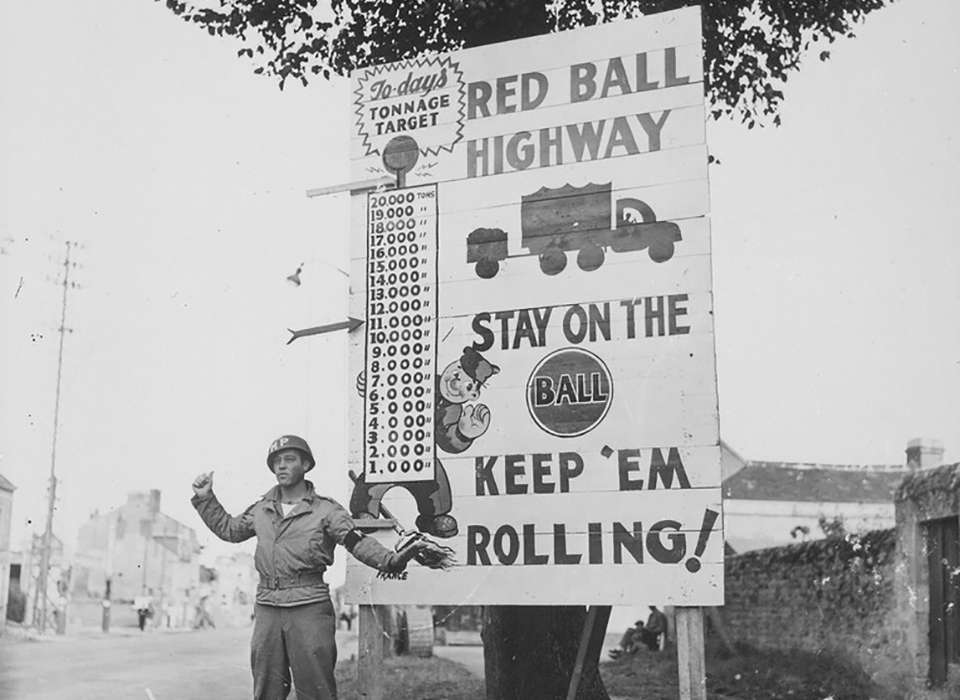
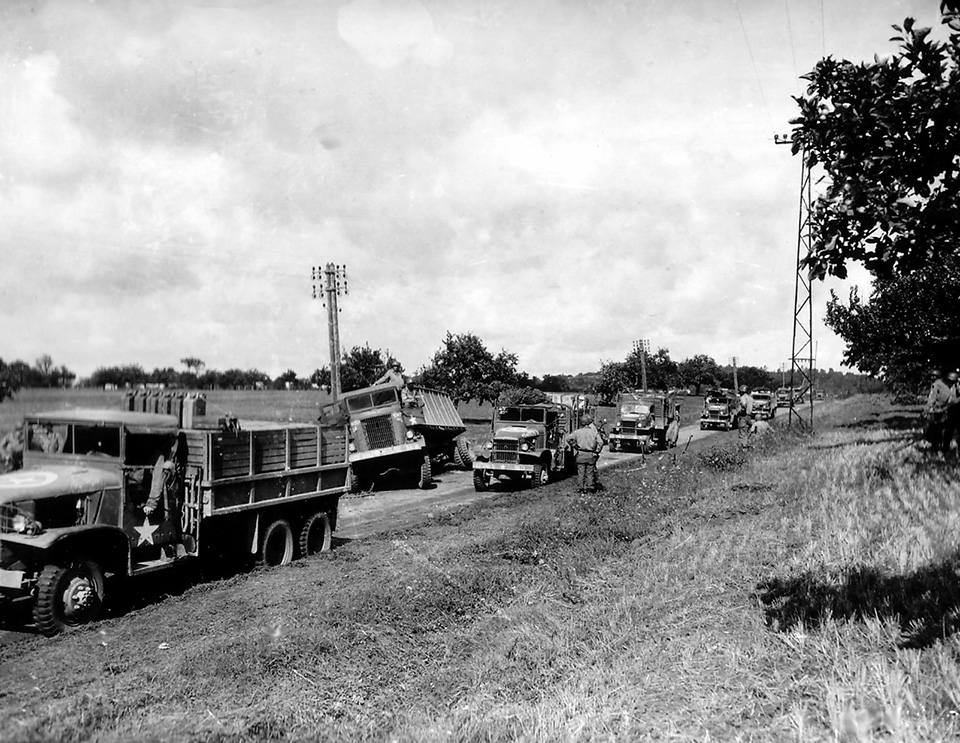
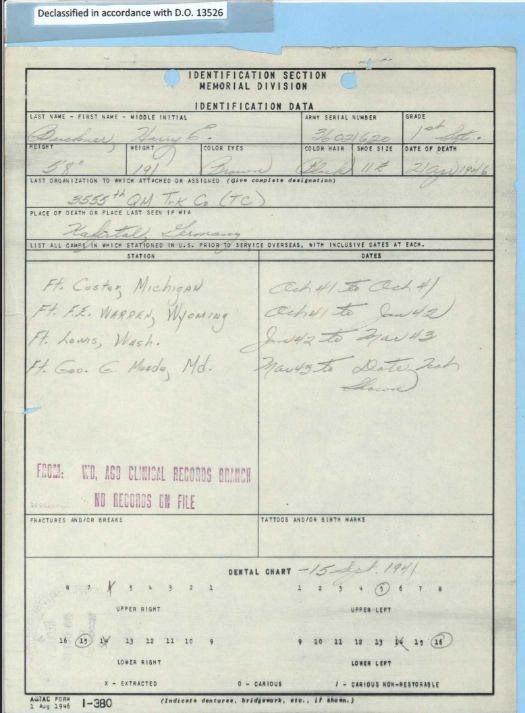
Commemoration
Harry Buckner died in a vehicle accident near Kafertal, Germany, on April 21, 1946. His remains were identified by his commanding officer, First Lieutenant Isadore E. Stein.
Buckner posthumously received the World War II Victory Medal and American Campaign Medal for his service in Europe during World War II. He is buried in Lorraine American Cemetery, Saint Avold, France.
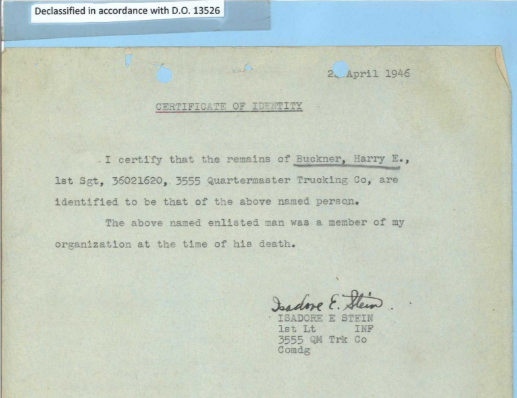
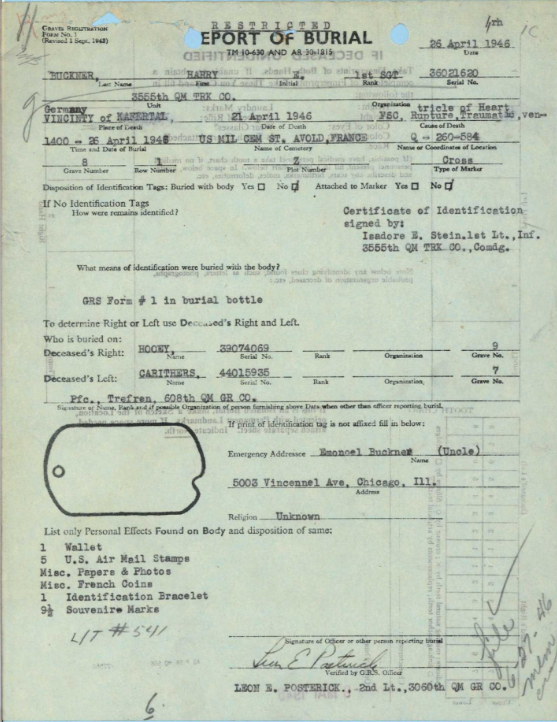
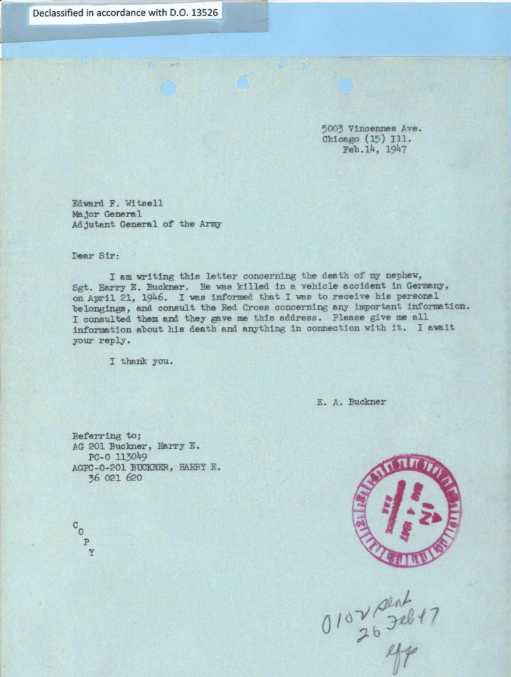
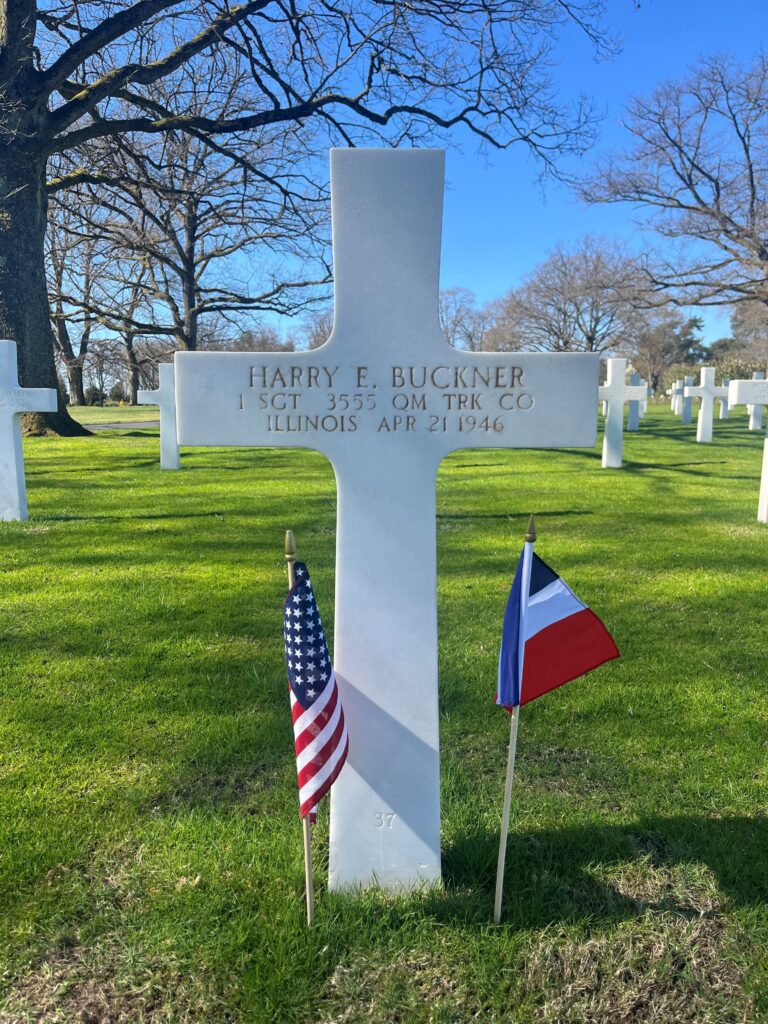
Bibliography
Primary Sources
Harry Buckner. Individual Deceased Personnel File, Department of the Army. National Archives and Records Administration – St. Louis.
Harry Buckner. World War II Final Pay Voucher. National Archives and Records Administration – St. Louis.
Harry Emanuel Buckner. World War II Draft Cards Young Men, 1940-1947. Digital Images. https://ancestryclassroom.com/.
H.M. Gousha Company. Metropolitan Chicago and vicinity. Map. American Geographical Society Library Digital Map Collection, University of Wisconsin-Milwaukee. https://collections.lib.uwm.edu/digital/iiif/agdm/18468/full/full/0/default.jpg
Illinois. Cook County. 1940 U.S. Census. Digital Images. https://ancestryclassroom.com/.
Lee, Russell. Negro Boys on Easter Morning. Photograph. 1941. Library of Congress (2017789025). https://www.loc.gov/item/2017789025/.
Missouri. Monroe County. 1910 U.S. Census. Digital Images. https://ancestryclassroom.com/.
Missouri. Monroe County. 1920 U.S. Census. Digital Images. https://ancestryclassroom.com/.
Missouri. Monroe County. 1930 U.S. Census. Digital Images. https://ancestryclassroom.com/.
Stecher-Traung Lithograph Corporation. War gardens for victory – Grow vitamins at your kitchen door. Lithograph. c.1939-1945. Library of Congress (96507418). https://www.loc.gov/item/96507418/.
Secondary Sources
“1Sgt Harry E. Buckner.” Find a Grave. Accessed November 18, 2024. https://www.findagrave.com/memorial/56653268/harry-e-buckner.
“American Campaign Medal.” U.S. Air Force’s Personnel Center. Accessed March 14, 2025. https://www.afpc.af.mil/Fact-Sheets/Display/Article/421947/american-campaign-medal/
Chicago Victory Gardens: Yesterday and Tomorrow. Film. May 13, 2011. Library of Congress (2021688677). https://www.loc.gov/item/2021688677/.
Dupont, Jill. “Chicago.” Oxford African American Studies Center. https://oxfordaasc.com/.
“Fort Custer during World War II.” Military History of the Upper Great Lakes. Accessed February 5, 2025. https://ss.sites.mtu.edu/mhugl/2015/10/11/fort-custer-during-world-war-2/.
“Fort George G. Meade.” U.S Army. Accessed February 5, 2025. https://home.army.mil/meade/about/history.
“Great Depression.” Encyclopedia of Chicago. Accessed December 23, 2024. http://www.encyclopedia.chicagohistory.org/pages/542.html.
“Harry E. Buckner.” American Battle Monuments Commission. Accessed November 18, 2024. https://www.abmc.gov/decedent-search/buckner%3Dharry.
“The History of Bronzeville.” University of Chicago. Accessed December 23, 2024. https://chicagostudies.uchicago.edu/bronzeville/bronzeville-history-bronzeville.
“The History of Fort D.A. Russell and F.E. Warren Air Force Base.” F.E. Warren Air Force Base. Accessed February 5, 2025. https://www.warren.af.mil/About-Us/Base-History/.
Johnson, Zada. “Bronzeville.” Oxford African American Studies Center. https://oxfordaasc.com/.
“‘Keep ‘em Rolling’: 82 Days on the Red Ball Express.” The National WWII Museum. Accessed February 5, 2025. https://www.nationalww2museum.org/war/articles/red-ball-express.
“What Can We Learn About World War II from Black Quartermasters?” The National WWII Museum. Accessed February 5, 2025. https://www.nationalww2museum.org/war/articles/world-war-ii-black-quartermasters.
“World War II.” Encyclopedia of Chicago. Accessed December 23, 2024. http://www.encyclopedia.chicagohistory.org/pages/1384.htm
“World War II Victory Medal.” Air Force’s Personnel Center. Accessed March 14, 2025. https://www.afpc.af.mil/Fact-Sheets/Display/Article/421906/world-war-ii-victory-medal/.
This profile was researched and created through the Researching Silent Heroes program, sponsored by the American Battle Monuments Commission.

